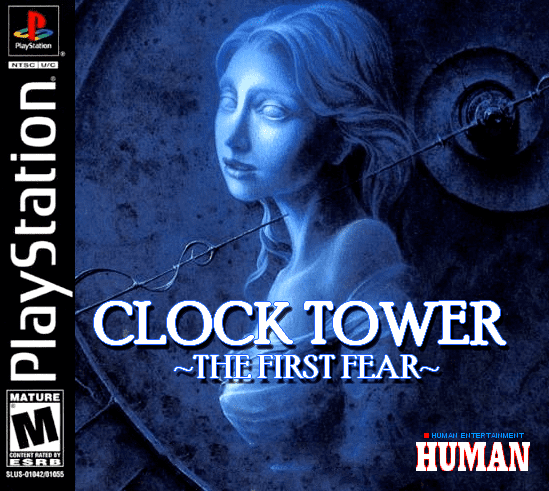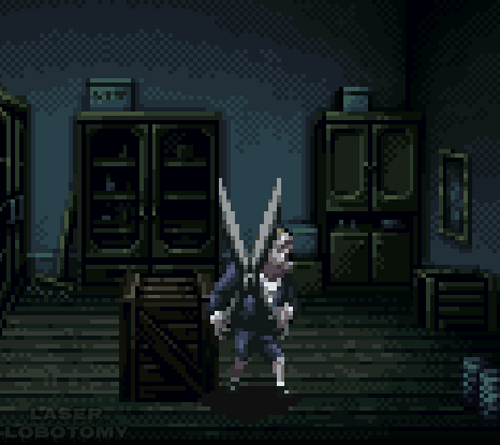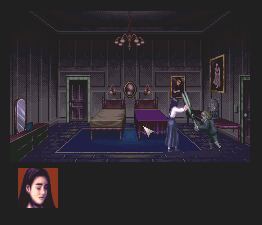Director(s) Hifumi Kono Artist(s) Akiyoshi Iijima Initial release date 14 September 1995 | Producer(s) Hiroyasu Ichizaki Composer(s) Kōji Niikura | |
 | ||
Programmer(s) Naoki SonodaNobuhiro Fujii Release date(s) September 14, 1995Super FamicomJP: September 14, 1995WindowsJP: March 28, 1997PlayStationJP: July 17, 1997WonderSwanJP: December 9, 1999 Platforms PlayStation, Super Nintendo Entertainment System, PlayStation Portable, Microsoft Windows, WonderSwan Genres Survival horror, Adventure game Similar Clock Tower games, Human Entertainment games, Survival horror games | ||
Clock Tower is a survival horror point-and-click adventure game developed and published by Human Entertainment for the Super Famicom in 1995. It is the first installment in the Clock Tower series. The story follows orphan Jennifer Simpson soon after she is adopted by the Barrows family along with other orphaned girls. With the introduction of Scissorman, the game's antagonist, one of the other children is killed. Jennifer must then explore the Barrows Mansion to find a way to escape while evading Scissorman, leading to one of the game's multiple endings. Clock Tower utlizes a point and click interface with the player controlling a cursor to direct Jennifer's actions.
Contents

Much of Clock Tower's plot and artistic style are inspired by the works of Italian horror film director Dario Argento, most notably Phenomena. Director Hifumi Kono loved horror films like this and wanted the game to feel like one. Many of the game's character graphics were digitized from photos of real people. Jennifer's movements were constructed from a woman in Human's planning division acting out the scenes. Her design was inspired by Jennifer Connelly's character in Phenomena.

The game sold "fairly well" upon release. An updated version, titled Clock Tower: The First Fear was ported to the PlayStation, WonderSwan, and Windows. Many years later, it was re-released again on the PlayStation Network, as well as Wii and Wii U Virtual Console. The game has never been officially released outside Japan, although fan translations exist. In retrospective reviews, the puzzles and exploration were found to be tedious. However, Clock Tower has been praised for its haunting atmosphere and is considered a predecessor to other horror video games and the survival horror genre.

Gameplay
Clock Tower is a survival horror point-and-click adventure game with 2D graphics. The player controls a cursor to direct the main character, Jennifer Simpson, and give commands such as investigating objects or opening doors. Jennifer can walk and run, although running will reduce her stamina, in which case she may recover her stamina by sitting on the floor. Jennifer's character portrait in the corner of the screen will change depending on her stamina level. In addition to interacting with objects in the game, Jennifer can also store them as inventory for later use. The layout of items changes with each play-through.
Jennifer is under the constant threat of a stalker named Scissorman. When Scissorman is confronted, the game will enter "panic mode." Depending on Jennifer's health status, she may begin to trip, slow down and eventually be killed. Jennifer cannot use weapons against Scissorman. Instead the player must find hiding spots throughout the mansion which are key to Jennifer's survival, or use traps placed in the environment. If caught, the player can rapidly press a button which allows them an attempt to escape. If Jennifer dies it is game over, returning the player to the title screen with an option to continue the game.
Plot
The story follows Jennifer Simpson, an orphan from the fictional Granite Orphanage in Romsdalen, Norway. She and other orphaned children named Laura, Anne, and Lotte are adopted in September 1995 by a wealthy recluse named Simon Barrows, who lives in a mansion known as the "Clock Tower", named after its predominant feature. After arriving at the mansion, Mary, the woman who brought the children to the mansion, leaves to find Mr. Barrows. When she takes an unusually long time, Jennifer offers to investigate. Upon leaving the room, she hears a scream coming from the main foyer. Jennifer returns to find the lights off and the girls missing. After finding either Laura or Anne killed, she finds herself being stalked by a murderous little boy with deformed features, wielding a huge pair of scissors, named the Scissorman.
While exploring the mansion, Jennifer searches for Mary's true intentions. Depending on choices made by the player, Jennifer will either discover Simon Barrows trapped in a jail cell, or her father's corpse. If the latter happens, Jennifer will find his death letter that tells of his account concerning Mary Barrows and her twins, Bobby and Dan. It says that he was trapped there for three days, until his death on November 10, 1986. Jennifer then visits a small church. If the player has collected all the necessary items and clues, then she gains access to the underground catacombs of the mansion. Jennifer sees a cloaked figure walking ahead of her; this is Mary. If Lotte did not need to rescue Jennifer from the jail cell, she can be found dying at an altar, and tells Jennifer about the switches in the clock tower. Otherwise, she rescues Jennifer from the jail cell, but is shot by Mary.
Jennifer enters a room, where she discovers Dan Barrows. Dan awakens and chases Jennifer to a steep cliff. She successfully climbs over, knocking down a can of kerosene which splashes onto a nearby candle. This triggers an explosion that immolates Dan, while Jennifer rides an elevator out of the catacombs. She ends up defeating Bobby in the clock tower.
Development
Clock Tower was directed by Hifumi Kono, who wished to use the game to pay homage to one of his favorite film directors, Dario Argento. Most notably, the game borrows many ideas from his film Phenomena. Clock Tower has strong relations to its plot and shares other similarities with Argento's 1980s films, such as occult themes, distressed young women, and bright colors atop a foggy setting. Kono had a passion for old horror films, and wanted Clock Tower to feel like one.
Kono described Clock Tower as an experimental project with a small budget and staff. His peers believed that a game where the protagonist runs away from the enemy would not work, but he continued on despite these concerns. Due to lack of staffing resources, developer Human Entertainment could not include mouse support and also needed to shrink the map down significantly. Although the graphics are two-dimensional, the mansion is designed within a 3D space. The character graphics in Clock Tower were created by digitizing photographs of real people, a popular technique of the time. The actress for Jennifer was a woman in Human's planning division. Many of the motions in the game came from her acting, such as hanging from a roof and stumbling in the hallway.
Release
Clock Tower was first released on the Super Famicom on September 14, 1995. According to Kono, the game sold "fairly well." It was later re-released under the title Clock Tower: The First Fear on PlayStation, Windows, and WonderSwan. This release featured a new dagger weapon, a new room, and minor scenario additions. The PlayStation and Windows versions also featured full motion video scenes, and minor graphical improvements. The WonderSwan version was rendered in black and white and plays slower.
Clock Tower was digitally re-released for the Wii and Wii U Virtual Console in Japan in 2010 and 2013 respecitvely. It has also reached multiple PlayStation devices via a release on the PlayStation Network in 2011, also exclusively in Japan. Clock Tower has not been officially released outside Japan; however, fan translations exist.
Reception
In a retrospective review, Hernando Vallejo of Hardcore Gaming 101 described Clock Tower as "one of the most thrilling experiences the [horror] genre can offer." He praised the game's graphics and sound for building a strong atmosphere. Allistair Pinsof of Destructoid noted that although Clock Tower aged poorly, it was still worth experiencing. He praised the graphics, story, and the Dario Argento-inspired style for creating a haunting mood and atmosphere. He also praised the multiple endings and unique gameplay design. However, he found Clock Tower failed to create an interesting adventure experience due to the difficulty of navigating the mansion layout, excessive item hunting, and simple puzzles. He criticized the game's attempt to place a 3D space within a 2D game, which created confusion when exploring. Despite these flaws, he still found Clock Tower worth playing, calling it "atmospheric horror at its most raw, for better or worse."
Legacy
Clock Tower has been called a "paragon for future horror games" and is considered instrumental in establishing the survival horror genre. It also solidified Human Entertainment as a developer along with Twilight Syndrome and Laplace no Ma.
